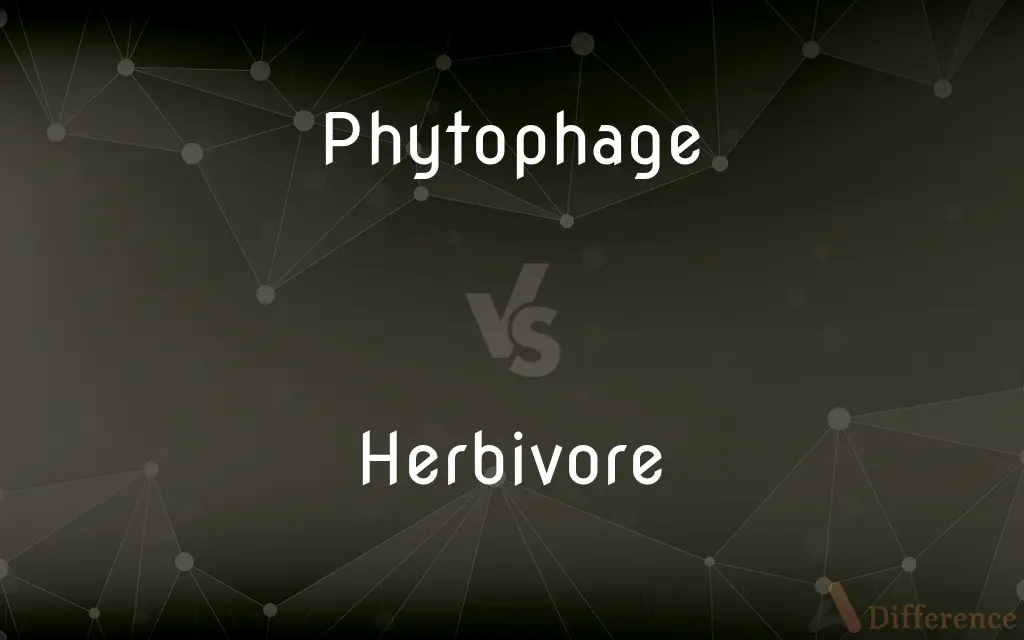Phytophage vs. Herbivore — What's the Difference?
By Tayyaba Rehman & Urooj Arif — Updated on April 21, 2024
Phytophage consumes plant parts and can include insects; herbivore exclusively eats plants, typically referring to larger animals like deer or elephants.

Difference Between Phytophage and Herbivore
Table of Contents
ADVERTISEMENT
Key Differences
A phytophage specifically refers to an organism that eats parts of plants, often insects or smaller animals that might specialize in certain types of plant material, like leaves or wood. On the other hand, a herbivore is generally any animal that consumes only plants, but this term is more commonly applied to larger animals and encompasses a broader diet including various plant parts.
Phytophages might target specific plant tissues, such as sap or seeds, which can influence their role in their respective ecosystems by potentially acting as pest species. Whereas herbivores often consume more substantial parts of plants such as leaves, stems, and roots, contributing significantly to shaping vegetation landscapes and influencing ecological balances.
The dietary habits of phytophages can lead to specialized adaptations like mouthparts designed for piercing or sucking. In contrast, herbivores may develop grinding teeth, complex stomachs for fermenting plant material, and other traits that aid in digesting a wide variety of plant matter.
Phytophages are usually smaller and might not directly compete with larger herbivores due to their differing dietary needs and niches within ecosystems. Conversely, herbivores can include massive animals like elephants or bison, significantly impacting their environments through activities like grazing.
Behavioral patterns also differ, with many phytophages, such as aphids, exhibiting behaviors that facilitate plant dependency, such as forming mutualistic relationships with ants. Herbivores, however, tend to have behaviors centered around migration and herd dynamics to exploit large areas of vegetation and avoid predation.
ADVERTISEMENT
Comparison Chart
Size
Generally small, e.g., insects
Ranges from small to large mammals
Dietary specificity
Often specific to parts of plants
Consumes a broad range of plant parts
Typical adaptations
Specialized mouthparts for specific plant tissues
Teeth and digestive systems for general plant digestion
Ecological impact
Can be pest species, affecting specific plants
Broadly shape vegetation and ecological balance
Behavioral characteristics
Often engage in mutualistic relationships
Often exhibit migratory and herd behaviors
Compare with Definitions
Phytophage
Part of complex food webs.
Phytophages are crucial prey for numerous predatory species.
Herbivore
Has adaptations for plant digestion.
Herbivores like horses have long digestive tracts suitable for fermenting cellulose.
Phytophage
Can be pest species in agriculture.
As a phytophage, the locust causes significant damage to crops by consuming foliage.
Herbivore
Includes various mammals and other animals.
The giant panda is a herbivore that primarily eats bamboo.
Phytophage
Influences plant health and survival.
Some phytophages, by feeding on seeds, can impact plant reproduction rates.
Herbivore
An animal that exclusively eats plants.
Cows, typical herbivores, graze on grass throughout the day.
Phytophage
An organism that eats plant parts.
The caterpillar, a common phytophage, feeds voraciously on leaves.
Herbivore
Impacts landscape and plant distribution.
Elephants, as herbivores, can alter forest landscapes by uprooting trees.
Phytophage
Often an insect feeding on specific plant tissues.
Phytophages like aphids suck sap directly from plant vessels.
Herbivore
Often lives in groups for protection.
Zebras, herbivores by nature, form large herds to evade predators.
Phytophage
(biology) herbivore
Herbivore
A herbivore is an animal anatomically and physiologically adapted to eating plant material, for example foliage or marine algae, for the main component of its diet. As a result of their plant diet, herbivorous animals typically have mouthparts adapted to rasping or grinding.
Herbivore
An animal that feeds chiefly on plants.
Herbivore
An organism that feeds chiefly on plants; an animal that feeds on herbage or vegetation as the main part of its diet.
Herbivore
One of the Herbivora.
Herbivore
Any animal that feeds chiefly on grass and other plants;
Horses are herbivores
The sauropod dinosaurs were apparently herbivores
Common Curiosities
Are there any specific adaptations of phytophages?
Yes, many have specialized mouthparts suited to their specific diet, like piercing or sucking mechanisms.
How do the diets of phytophages and herbivores impact their ecosystems?
Phytophages often affect specific plants or parts, while herbivores can have a more general impact on vegetation and landscape.
What are common examples of herbivores?
Examples include giraffes, bison, and sheep, all of which feed primarily on plants.
What role do herbivores play in the environment?
Herbivores help shape vegetation patterns, distribute plant seeds, and are key in food webs.
Can a phytophage be a herbivore?
Yes, all phytophages are technically herbivores, but not all herbivores are considered phytophages due to their broader dietary habits.
What adaptations help herbivores digest plants?
Many have complex stomachs to break down tough plant fibers and cellulose.
What defines a phytophage?
A phytophage is an organism that feeds on plant parts, often specializing in specific tissues like leaves or sap.
What animals are considered herbivores?
Animals that eat only plants, including mammals like deer and elephants, are considered herbivores.
Do phytophages have any natural predators?
Yes, they are preyed upon by a variety of animals, including birds, reptiles, and other insects.
Do phytophages affect agriculture?
Yes, many are considered pests because they can cause significant damage to crops.
Can the behavior of herbivores lead to changes in their habitat?
Yes, through activities like grazing, herbivores can lead to significant changes in their habitats.
How do phytophages and herbivores differ in size?
Phytophages tend to be smaller, often insects, whereas herbivores range from small to very large mammals.
How do phytophages influence plant reproduction?
By consuming seeds or flowers, they can directly impact plant reproductive success.
How do the feeding habits of phytophages compare to those of general herbivores?
Phytophages often focus on specific plant parts, whereas general herbivores consume a wider range of plant material.
Are there herbivores that only eat one type of plant?
Yes, some herbivores, like the koala which primarily eats eucalyptus leaves, are highly specialized.
Share Your Discovery

Previous Comparison
Karate vs. Judo
Next Comparison
CMS vs. FrameworkAuthor Spotlight
Written by
Tayyaba RehmanTayyaba Rehman is a distinguished writer, currently serving as a primary contributor to askdifference.com. As a researcher in semantics and etymology, Tayyaba's passion for the complexity of languages and their distinctions has found a perfect home on the platform. Tayyaba delves into the intricacies of language, distinguishing between commonly confused words and phrases, thereby providing clarity for readers worldwide.
Co-written by
Urooj ArifUrooj is a skilled content writer at Ask Difference, known for her exceptional ability to simplify complex topics into engaging and informative content. With a passion for research and a flair for clear, concise writing, she consistently delivers articles that resonate with our diverse audience.
















































